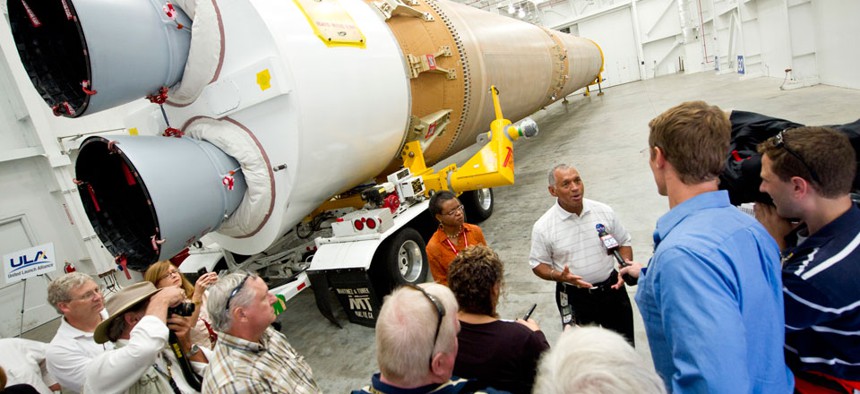Who’s Behind the Supply of Russian Rocket Engines to the US Is Still a Murky Question

NASA Administrator Charles Bolden, stands in front of the ULA-made Atlas V first stage booster while taking questions from the media NASA/AP
While the US is issuing ultimatums and threatening to jack up sanctions on Russia, it appears the limited restrictions deployed so far aren’t always working.
The US is issuing ultimatums and threatening to jack up sanctions on Russia, but it appears the limited restrictions deployed so far aren’t always stopping Russians they’re aimed at from doing business in the US.
Take the man known as the “Russian Rupert Murdoch,” the oligarch Yuri Kovalchuk. The media mogul and financier owns a large stake in Bank Rossiya, which in turn owns 40% of a public US company called CTC Media through a Cyprus shell company. Kovalchuk and his bank were sanctioned earlier this year because of their closeness to president Vladimir Putin’s regime, and so CTC has recused the directors appointed by the Russians and is putting their dividends in escrow.
The twist, however, is that CTC is also working closely with a Russian advertising firm, Video International. Bank Rossiya says it owns only 16% of the company, which would exempt Video International from the US sanctions on Bank Rossiya. But Bloomberg revealed yesterday, citing a well-placed source, that Video International is in fact directly controlled by Bank Rossiya, through a different series of Cyprus shell firms. Because of secrecy rules there, it’s almost impossible to prove who the real owners are. Last year, CTC paid Video International $78 million.
Could something similar be going on with the Russian company supplying rocket engines to the US military?
The engine, known as the RD-180, is bought from a company called RD Amross. But it doesn’t actually make the engine; it’s a joint venture between a US firm and the US subsidiary of a Russian one, NPO Energomash. The subsidiary is registered in Delaware, a state with strict secrecy rules. NPO Energomash, which is state-owned, makes the engines and sells them to RD Amross, which in turn sells them to a Boeing-Lockheed Martin joint venture, United Launch Association (ULA).
ULA signed a multi-billion dollar contract with the US government last December for 36 launches. ULA’s rival, Elon Musk’s SpaceX, sued the government for awarding the deal without competition. The judge in the case initially issued an injunction blocking the purchase of Russian engines because Dmitry Rogozin, who oversees Russia’s defense-industrial complex, is now under US sanctions after Russia’s invasion of Crimea. The injunction was overturned after US officials told the judge that they had no evidence Rogozin would benefit personally from the sale of the engines.
Last week, however, US senator John McCain asked the Department of Defense to investigate the imports. He says he has reason to believe that what the US pays RD Amross for the engines may be more than three times as much as what RD Amross pays NPO Energomash. He wants to know if taxpayers are getting ripped off and by whom—he’s asked US defense officials to determine the price RD Amross pays and identify “all nominal and beneficial owners” of RD Amross and of NPO Energomash’s US subsidiary. The implication is that they may not be who they claim to be; McCain notes that “the Russian procurement process is rife with inefficiency and corruption that benefits insiders while boosting retail prices.”
That will put US defense officials in a bit of a quandary: They’ve awarded a multi-billion dollar contract to ULA, but apparently without digging sufficiently into the practices of RD Amross or its pricing. SpaceX, in the latest update to its lawsuit, says this is a violation of the government contracting laws.
However, it all might become academic if tensions don’t subside. Rogozin has said Russia will not export further engines for military use, despite the end of the US injunction, though ULA will take delivery of five more this year.
Reprinted with permission from Quartz. The original story can be found here.



